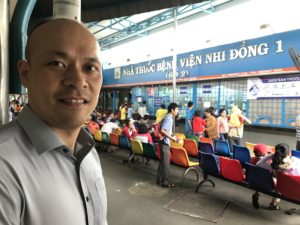I grew up privileged. Access to clean water, food, health care, and education was never an issue during my childhood in California. While we were never wealthy from an American perspective, we always had enough to meet our basic needs. This privilege is something most of the world’s population lacks, and I am mindful that small changes to my own family’s circumstances could easily have shifted our fortune for the worse. It was luck that enabled my family to leave Vietnam for America in 1975 just before the war ended, ensuring we did not have to suffer through the country’s rebuilding period, and it drives me to give back.
After a 5-year career in technology, creating information systems for universities, I decided to leave to follow my dream of becoming a photographer and traveling the world. I photographed whatever interested me, selling my photos to fund my travel and volunteer activities. The people I met during this period were inspirational, and it was their stories and hard work that moved me to find a way to help those in need.

While facilitating small-scale health projects for communities in Southeast Asia, I was interested in having a greater impact and therefore returned to school and got a Masters of Public Health degree in 2008 from the Johns Hopkins Bloomberg School of Public Health. Shortly afterwards, I joined CHAI as a Program Coordinator in my native Vietnam and got to fulfill another dream of understanding my heritage, not just as a distinct war event from an American perspective as most U.S. history books portray, but as a living, evolving, dynamic country in a fast growing part of the world.
I am proud of our work and close partnership with the Ministry of Health in strengthening Vietnam’s health system capacity and in helping them reach national health targets. When CHAI began work here in 2006, only 9 percent of children were receiving lifesaving antiretroviral therapy for HIV/AIDS. By 2015, that number had increased to 86 percent nationally. In provinces where CHAI provided technical support, 97 percent of children were surviving after 12 months on antiretroviral therapy, compared to a national average of 88 percent.
CHAI helped establish an Early Infant Diagnosis testing program to detect HIV in infants. Today this program tests 1,800 infants annually for HIV and has started 79 percent of them successfully on antiretroviral therapy. To reduce tuberculosis, we introduced isoniazid preventative therapy which, combined with anti-retroviral therapy, reduced TB incidences by 97 percent among nearly 2,000 children living with HIV. A CHAI-initiated SMS-delivered referral-support software was shown to reduce loss to follow-up of HIV-diagnosed patients registering for treatment by 50 percent, addressing one of the biggest challenges in HIV programming.
While these are the government’s achievements, I am proud that CHAI’s staff played a significant role along with other partners. And there is still much more to do.
CHAI empowers staff to use our creative freedom to solve large challenges with minimal bureaucracy, whether it’s upstream market-shaping work or building government-led, strong, and sustainable health systems in countries. CHAI’s values and structure facilitates our impact.
In the future, eliminating malaria and hepatitis C, and minimizing the TB burden in the Mekong region are within reach. Ambitious goals like these are what drive me to continue to carry out this lifesaving work.
More World AIDS Day coverage:
Landmark HIV drug deal to reduce side effects, keep people on treatment
Blog: From volunteer to COO, working on Tanzania’s first-ever HIV/AIDS treatment plan
Blog: How ‘miracle’ of AIDS patients’ survival gives hope for future
The state of the antiretroviral market today
CHAI Access Program launches online HIV product toolkit





